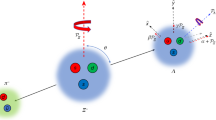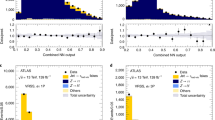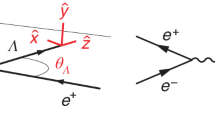Abstract
Equal amounts of matter and antimatter are predicted to have been produced in the Big Bang, but our observable Universe is clearly matter-dominated. One of the prerequisites1 for understanding this elimination of antimatter is the nonconservation of charge-parity (CP) symmetry. So far, two types of CP violation have been observed in the neutral K meson (K0) and B meson (B0) systems: CP violation involving the mixing2 between K0 and its antiparticle  (and likewise3,4 for B0 and
(and likewise3,4 for B0 and  ), and direct CP violation in the decay of each meson5,6,7,8. The observed effects for both types of CP violation are substantially larger for the B0 meson system. However, they are still consistent with the standard model of particle physics, which has a unique source9 of CP violation that is known to be too small10 to account for the matter-dominated Universe. Here we report that the direct CP violation in charged B±→K±π0 decay is different from that in the neutral B0 counterpart. The direct CP-violating decay rate asymmetry,
), and direct CP violation in the decay of each meson5,6,7,8. The observed effects for both types of CP violation are substantially larger for the B0 meson system. However, they are still consistent with the standard model of particle physics, which has a unique source9 of CP violation that is known to be too small10 to account for the matter-dominated Universe. Here we report that the direct CP violation in charged B±→K±π0 decay is different from that in the neutral B0 counterpart. The direct CP-violating decay rate asymmetry,  (that is, the difference between the number of observed B-→K-π0 event versus B+→K+ π0 events, normalized to the sum of these events) is measured to be about +7%, with an uncertainty that is reduced by a factor of 1.7 from a previous measurement7. However, the asymmetry
(that is, the difference between the number of observed B-→K-π0 event versus B+→K+ π0 events, normalized to the sum of these events) is measured to be about +7%, with an uncertainty that is reduced by a factor of 1.7 from a previous measurement7. However, the asymmetry  for
for  versus B0→K+π- is at the -10% level7,8. Although it is susceptible to strong interaction effects that need further clarification, this large deviation in direct CP violation between charged and neutral B meson decays could be an indication of new sources of CP violation—which would help to explain the dominance of matter in the Universe.
versus B0→K+π- is at the -10% level7,8. Although it is susceptible to strong interaction effects that need further clarification, this large deviation in direct CP violation between charged and neutral B meson decays could be an indication of new sources of CP violation—which would help to explain the dominance of matter in the Universe.
This is a preview of subscription content, access via your institution
Access options
Subscribe to this journal
Receive 51 print issues and online access
$199.00 per year
only $3.90 per issue
Buy this article
- Purchase on Springer Link
- Instant access to full article PDF
Prices may be subject to local taxes which are calculated during checkout


Similar content being viewed by others
References
Sakharov, A. D. Violation of CP invariance, C asymmetry, and baryon asymmetry of the Universe. Pis'ma Zh. Eksp. Teor. Fiz. 5, 32–35 (1967); JETP Lett. 5, 24–27 (1967)
Christenson, J. H., Cronin, J. W., Fitch, V. L. & Turlay, R. Evidence for the 2π decay of the meson. Phys. Rev. Lett. 13, 138–140 (1964)
Aubert, B. et al. (BaBar Collaboration). Observation of CP violation in the B0 meson system. Phys. Rev. Lett. 87, 091801 (2001)
Abe, K. et al. (Belle Collaboration). Observation of large CP violation in the neutral B meson system. Phys. Rev. Lett. 87, 091802 (2001)
Alavi-Harati, A. et al. (KTeV Collaboration). Observation of direct CP violation in K S,L→ππ decays. Phys. Rev. Lett. 83, 22–27 (1999)
Fanti, V. et al. (NA48 Collaboration). A new measurement of direct CP violation in two pion decays of the neutral kaon. Phys. Lett. B 465, 335–348 (1999)
Chao, Y. et al. (Belle Collaboration). Evidence for direct CP violation in B0→K+π- decays. Phys. Rev. Lett. 93, 191802 (2004)
Aubert, B. et al. (BaBar Collaboration). Direct CP violating asymmetry in B0→K+π- decays. Phys. Rev. Lett. 93, 131801 (2004)
Kobayashi, M. & Maskawa, T. CP violation in the renormalizable theory of weak interaction. Prog. Theor. Phys. 49, 652–657 (1973)
Cohen, A. G., Kaplan, D. B. & Nelson, A. E. Progress in electroweak baryogenesis. Annu. Rev. Nucl. Part. Sci. 43, 27–70 (1993)
Kurokawa, S. & Kikutani, E. Overview of the KEKB accelerators. Nucl. Instrum. Meth. A 499, 1–7 (2003)
Abashian, K. et al. (Belle Collaboration). The Belle detector. Nucl. Instrum. Meth. A 479, 117–232 (2002)
Aubert, B. et al. (BaBar Collaboration). Observation of CP violation in B0→K+π- and B0→π+π-. Phys. Rev. Lett. 99, 021603 (2007)
Abulencia, A. et al. (CDF Collaboration). Observation of and measurements of branching fractions of charmless two-body decays of B0 and mesons in collisions at TeV. Phys. Rev. Lett. 97, 211802 (2006)
Keum, Y. Y. & Sanda, A. I. Possible large direct CP violations in charmless B decays: Summary report of the PQCD method. Phys. Rev. D 67, 054009 (2003)
Beneke, M. & Neubert, M. QCD factorization for B→PP and B→PV decays. Nucl. Phys. B 675, 333–415 (2003)
Aubert, B. et al. (BaBar Collaboration). Study of B0→π0π0, B±→π±π0, and B±→K±π0 decays, and isospin analysis of B→ππ decays. Phys. Rev. D 76, 091102(R) (2007)
Chiang, C.-W., Gronau, M., Rosner, J. L. & Suprun, D. A. Charmless B→PP decays using flavor SU(3) symmetry. Phys. Rev. D 70, 034020 (2004)
Charng, Y.-Y. & Li, H-n. Weak phases from B→ππ, Kπ decays. Phys. Rev. D 71, 014036 (2005)
Hou, W.-S., Nagashima, M. & Soddu, A. Difference in B+ and B0 direct CP asymmetry as an effect of a fourth generation. Phys. Rev. Lett. 95, 141601 (2005)
Baek, S., Hamel, P., London, D., Datta, A. & Suprun, D. A. The B→Kπ puzzle and new physics. Phys. Rev. D 71, 057502 (2005)
Baek, S. & London, D. Is there still a B→πK puzzle? Phys. Lett. B 653, 249–253 (2007)
Li, H.-n., Mishima, S. & Sanda, A. I. Resolution to the B→πK puzzle. Phys. Rev. D 72, 114005 (2005)
Barberio, E. et al. (Heavy Flavor Averaging Group). Averages of b-hadron properties at the end of 2006. Preprint at 〈http://arXiv.org/abs/0704.3575〉 (2007)
Beneke, B. Corrections to sin(2β) from CP asymmetries in B0→(π0, ρ0, η, η′, ω, φ)K S decays. Phys. Lett. B 620, 143–150 (2005)
Cheng, H.-Y., Chua, C.-K. & Soni, A. Effects of final-state interactions on mixing-induced CP violation in penguin-dominated B decays. Phys. Rev. D 72, 014006 (2005)
Hou, W.-S., Li, H-n., Mishima, S. & Nagashima, M. Fourth generation CP violation effect on B→Kπ, φK and ρK in next-to-leading-order perturbative QCD. Phys. Rev. Lett. 98, 131801 (2007)
Atwood, D. & Soni, A. The possibility of large direct CP violation in B→Kπ-like modes because of long distance rescattering effects and implications for the angle γ.. Phys. Rev. D 58, 036005 (1998)
Gronau, M. A precise sum rule among four B→Kπ CP asymmetries. Phys. Lett. B 627, 82–88 (2005)
Kakuno, H. et al. Neutral B flavor tagging for measurement of mixing-induced CP violation at Belle. Nucl. Instrum. Meth. A 533, 516–531 (2004)
Acknowledgements
We thank the KEKB group for the operation of the accelerator, the KEK Cryogenics group for the operation of the solenoid, and the KEK computer group and the NII for computing and Super-SINET network support. We acknowledge support from MEXT and JSPS (Japan); ARC and DEST (Australia); NSFC and KIP of CAS (China); DST (India); MOEHRD, KOSEF and KRF (Korea); KBN (Poland); MES and RFAAE (Russia); ARRS (Slovenia); SNSF (Switzerland); NSC and MOE (Taiwan); and the DOE (USA).
Author information
Authors and Affiliations
Consortia
Corresponding author
Supplementary information
Supplementary Information
The file contains Supplementary Notes with Supplementary Figures 1-2 and Supplementary Table 1. The text describes the Belle detector, explains how signals are extracted and lists the systematic uncertainties of the measurements. (PDF 722 kb)
Rights and permissions
About this article
Cite this article
The Belle Collaboration. Difference in direct charge-parity violation between charged and neutral B meson decays. Nature 452, 332–335 (2008). https://doi.org/10.1038/nature06827
Received:
Accepted:
Issue Date:
DOI: https://doi.org/10.1038/nature06827
This article is cited by
-
More flavor SU(3) tests for new physics in CP violating B decays
Journal of High Energy Physics (2014)
-
Progress and bottleneck in induced pluripotency
Cell Regeneration (2012)
-
Measurement of b-hadron branching fractions for two-body decays into charmless charged hadrons
Journal of High Energy Physics (2012)
-
$ {\bar{B}_s} \to \phi {\rho^0} $ and $ {\bar{B}_s} \to \phi {\pi^0} $ as a handle on isospin-violating New Physics
Journal of High Energy Physics (2011)
-
The Isotopic Field Charge Spin Assumption
International Journal of Theoretical Physics (2011)
Comments
By submitting a comment you agree to abide by our Terms and Community Guidelines. If you find something abusive or that does not comply with our terms or guidelines please flag it as inappropriate.



